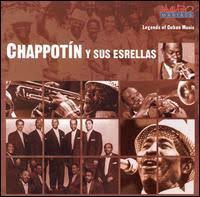FÉLIX CHAPPOTTÍN, FAMOUS TRUMPETER AND BANDLEADER. THE “CUBAN LOUIS ARMSTRONG”. VIDEOS
The Chappottín Musical Ensemble, also known as ‘Chappottín y sus Estrellas’, is a group of Cuban son from Havana, Cuba. The band since its founding has been dedicated to a traditional son with a variety of different stylistic elements such as son-montuno, guajira, guaracha, mambo, danzón, danzonette, charanga, afro-son, bembe, rumba Cubana (composed of yambú, Columbia and guaguanco), and cha cha cha.
The founding of the band dates back to the 1940s. Its founder, Arsenio Rodríguez, was one of the most recognized bandleaders in the country with great influences on Latin jazz and salsa for decades to come. With the Conjunto, he was the first to add reed and brass instruments to a Latin band at the time.
In 1950 the group was renewed by the famous trumpeter Félix Chappottín, the pianist Lilí Martínez, the singer Miguelito Cuní and other members of the Arsenio Rodríguez group, which was partially dissolved after Arsenio’s departure to the United States.
Since his childhood, Félix Chappottín Lage was very fond of music, which attracted him greatly, and that is why at an early age he began to study with Professor Venancio González the wind instruments: cornet, tuba, oboe, and later the euphonium.
 VIDEOS – FELIX CHAPPOTTIN STARS PLAYING
VIDEOS – FELIX CHAPPOTTIN STARS PLAYING
His study facilities led him to join the Guanajay children’s band, a small town where he occasionally lived at that time. As a curious and interesting fact we can add that when Luciano Pozo González (Chano) was 8 years old, his mother Encarnación González passed away, and this makes it possible for Félix’s father, Julio Chappottín to join the named Félix’s mother, Natalia Lage, who ends to raise Chano Pozo.
FELIX CHAPPOTTIN’S ARTISTIC CAREER
The trumpeter Chappottín dabbled in countless Havana troupes induced by his uncle Margarito Lage, who was an expert on these issues.
In 1924 he joined “La Estudiantina Orquídea de Américo González”, and later joined the then famous “Septeto Habanero” in 1927, as a substitute for the trumpeter Rafael Hernández, (El Piche), being, in turn, the second trumpeter who interprets they are in our country and possibly in the world.
For reasons very inherent to the music class, Félix leaves the Septeto Habanero and begins to move to the following groups: Septeto Colín, Munamar, Universo, Alabama, Boloña, and together with the legendary Jesús Gutiérrez (Tata) they organize the Sexteto Bolero. Later, he joined the Sexteto Carabina de Ases group, but Chappottín did not support himself in any group and continued his journey through the group América, La Gloria Cubana, Orquesta Anacaona, directed by the Castro sisters. Later, he joined the “Conjunto Azul” led by his foster brother Chano. However, every time they called him from a troupe, “Chapo” would go there with his trumpet.
Performing in the well-named group “Jóvenes del Cayo” at the end of the 1940s, he was picked up by Arsenio Rodríguez. Without thinking twice, Chapottín enlisted with the Ciego Maravilloso where he finally settled in this group, one of the best sonero of the trumpet in Cuba. Next, we are going to make as much as possible the recordings of this Cuban musician in the “Septeto Habanero”.
From that moment on, the original Arsenio Rodríguez Musical Group and his stars were transformed into Chappottin’s Ensemble and his Stars. The group was led by Félix Chappottín with Luis (Lilí) Martínez Griñán as the arranger and Miguelito Cuni the singer. Under the direction of Félix Chappottín, only compared to the famous American trumpeter Louis Satchmo Armstrong, the band achieved international fame, dancers that move and entertained in different parts of the world.
OWN STYLE OF THE MUSICAL BAND
The key to this success known to Chappottín and the Stars of him has been his fidelity and his pride in the exhibition of African cultural elements in the son as a Cuban artistic manifestation and music. This constant preservation for years has entertained dancers and lovers of Caribbean music all over the world.
The son and grandson of Félix Chappottín have been in charge of the Conjunto Chappottín and its stars since Félix died in 1983. Currently, his main task of leading the group has been to ensure the continuity of the repertoire of legendary bands, while enriching it with new creations. The current leadership has maintained the band’s rhythmic and sonic identity as taught by the pioneers of unforgettable Cuban popular dance music.
DISCOGRAPHY AND SELECTION.
1992: Stars of Cuba
1993: Chappottín and his Ensemble
1993: Tropical Flavor
1995: Miguelito Cuni sings
1995: Chappotín and his Stars
1995: Gold Series
1997: Let It Go
1999: Senores del Son
1999: My are my are my are
2000: We’re Still Here Chappottineando
2001: Ladybugs
2001: Mariquitas y Chicharrones
2001: Havana Social Club
2002: La Guarapachanga
2003: Son, Boleros y Montuno Con Sabor a Quimbombo
2003: Una Nueva Generacion
2006: Conjunto Chappottín y Sus Estrellas.
2007: Vuelven Los Senores Del Son
FELIX CHAPPOTTÍN, FAMOSO TROMPETISTA CUBANO Y DIRECTOR DE ORQUESTA. EL “LOUIS ARMSTRONG CUBANO”. VIDEOS
El Conjunto Musical Chappottín, también conocido como ‘Chappottín y sus Estrellas’, es un conjunto de son cubano de La Habana, Cuba. La banda desde su fundacion se ha dedicado al son tradicional con una variedad de diferentes elementos estilísticos como son-montuno, guajira, guaracha, mambo, danzón, danzonette, charanga, afro-son, bembe, rumba cubana (compuesta por yambú, columbia y guaguanco), y cha cha cha.
La fundación de la banda se remonta a la década de 1940. Su fundador, Arsenio Rodríguez, fue uno de los líderes de bandas más reconocidos del país con grandes influencias en el jazz latino y la salsa de las próximas décadas. Con su Conjunto fue el primero en agregar instrumentos de caña y metal a una banda latina en ese momento.
En 1950 se renueva el conjunto por el famoso trompetista Félix Chappottín, la pianista Lilí Martínez, el cantante Miguelito Cuní y otros integrantes del conjunto de Arsenio Rodríguez, que se disolvió parcialmente tras la marcha de Arsenio a Estados Unidos.
Desde su niñez, su fundador y director Félix Chappottín Lage, resultó muy aficionado a la música, que lo atraía grandemente, y es así que de temprana edad comenzó a estudiar con el profesor Venancio González los instrumentos de vientos: cornetín, tuba, oboe y más tarde el bombardino.
 VIDEOS – FELIX CHAPPOTTIN ACTUANDO
VIDEOS – FELIX CHAPPOTTIN ACTUANDO
Sus facilidades de estudios lo llevaron a ingresar en la banda infantil de Guanajay, un pueblito donde ocasionalmente vivía por aquella fecha. Como dato curioso e interesante podemos agregar que cuando Luciano Pozo González (Chano) contaba 8 años su madre Encarnación González fallece, y esto hace posible que el padre de Félix, Julio Chappottín se una a la mamá de Félix nombrada, Natalia Lage, quién termina de criar a Chano Pozo.
CARRERA ARTISTICA DE FELIX CHAPPOTTIN
El trompetista Chappottín incursionó por innumerables comparsas habaneras inducido por su tío Margarito Lage, quién era experto en estas cuestiones.
En el año 1924 ingresa en “La Estudiantina Orquídea de Américo González”, para más tarde ingresar en 1927 al ya famoso “Septeto Habanero”, como sustituto del trompetista Rafael Hernández, (El piche), siendo a su vez el segundo trompetista que interpreta el son en nuestro país y posiblemente en el Mundo.
Por razones muy inherente a la clase musical, Félix abandona al Septeto Habanero y comienza a trasladarse a las siguientes agrupaciones: Septeto Colín, Munamar, Universo, Alabama, Boloña, y junto al legendario Jesús Gutiérrez (Tata) organizan el Sexteto Bolero. Más tarde integra la agrupación Sexteto Carabina de Ases, Pero Chappottín no se sostiene en ningún grupo y continúa su periplo por el conjunto América, La Gloria Cubana, Orquesta Anacaona, dirigida por las hermanas Castro. Posteriormente se inserta en el “Conjunto Azul” dirigido por su hermano de crianza Chano. No obstante cada vez que lo llamaban de una comparsa, allá iba “Chapo” con su trompeta.
Actuando en el bien nombrado conjunto “Jóvenes del Cayo” a finales de los años 1940, lo viene a buscar Arsenio Rodríguez. Chapottín sin pensarlo dos veces se enrola junto al Ciego Maravilloso donde al fin se asienta en esta agrupación, uno de los mejores sonero de la trompeta en Cuba. A continuación vamos a realizar en lo posible las grabaciones de este músico cubano en el “Septeto Habanero”.
 VIDEOS – FELIX CHAPPOTTIN ACTUANDO
VIDEOS – FELIX CHAPPOTTIN ACTUANDO
A partir de ese momento, el original Grupo Musical de Arsenio Rodríguez y sus estrellas se transformó en el Conjunto de Chappottin y sus Estrellas. El grupo estaba encabezado por Félix Chappottín con Luis (Lilí) Martínez Griñán como el arreglista y Miguelito Cuni el cantante. Bajo la dirección de Félix Chappottín, sólo comparado con el afamado trompetista norteamericano Louis Satchmo Armstrong, la banda alcanzó la fama internacional, bailarines que se mueven y divertida en diferentes partes del mundo.
ESTILO PROPIO DE LA BANDA MUSICAL
La clave de este éxito conocido por Chappottín y sus Estrellas ha sido su fidelidad y su orgullo en la exhibición de los elementos culturales africanos en el hijo como manifestación artística cubana y la música. Esta preservación constante durante años ha entretenido y bailarines amantes de la música caribeña en todo el mundo.
El hijo y nieto de Félix Chappottín han estado a cargo del Conjunto Chappottín y sus estrellas ya que Félix murió en 1983. En la actualidad, su principal tarea de dirigir el grupo ha sido asegurar la continuidad del repertorio de bandas legendarias, mientras que la enriquece con nuevas creaciones. La dirección actual ha mantenido la identidad sonorica y rítmica de la banda como fue enseñado por los pioneros de la música cubana inolvidable baile popular.
DISCOGRAFIA Y SELECCION.
1992: Estrellas de Cuba
1993: Chappottín y su Conjunto
1993: Sabor Tropical
1995: Canta Miguelito Cuni
1995: Chappotín y sus Estrellas
1995: Serie de Oro
1997: Que Se Funan
1999: Senores del Son
1999: Mi son mi son mi son
2000: Seguimos Aqui Chappottineando
2001: Mariquitas y Chicharrones
2001: Havana Social Club
2002: La Guarapachanga
2003: Son, Boleros y Montuno Con Sabor a Quimbombo
2003: Una Nueva Generacion
2006: Conjunto Chappottín y Sus Estrellas.
2007: Vuelven Los Senores Del Son
Agencies/ WIki/ FelixChappottin/ Internet Photos/ YouTube/ Arnoldo Varona/ www.TheCuban History.com
THE CUBAN HISTORY, HOLLYWOOD.









